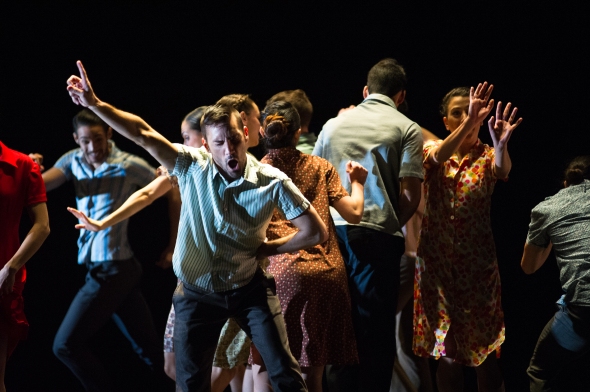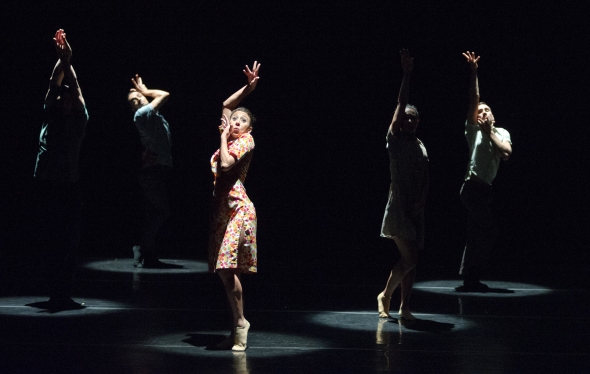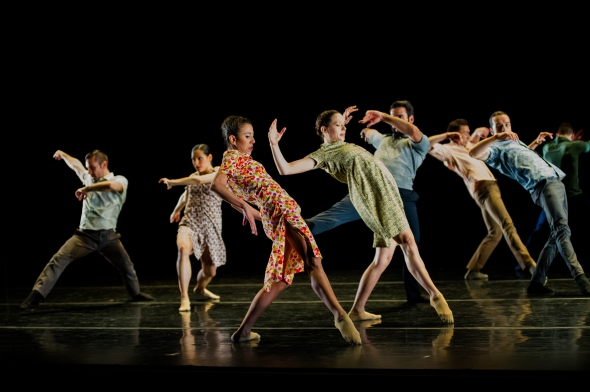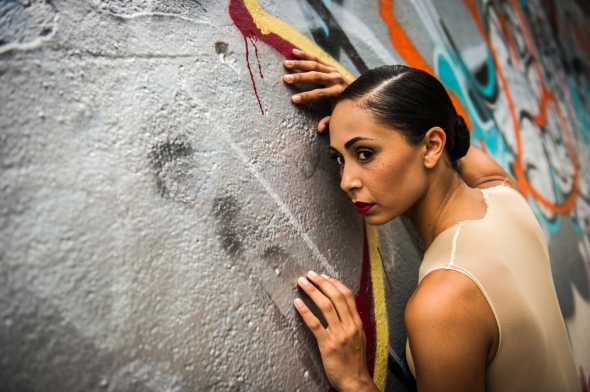CONVERSACIONES: GUSTAVO RAMÍREZ SANSANO & Flabbergast
Posted: November 16, 2016 Filed under: Behind-the-Scenes @ BH, Performances, The Apollo | Tags: Ballet Hispanico, Flabbergast, Gustavo Ramírez Sansano, The Apollo Theater Leave a commentCelebrating over 45 years in bringing audiences and communities together to celebrate and explore the ever-changing diversity of Latino cultures, Ballet Hispánico returns to the Apollo Theater November 18-19, 2016 with Reshape / Reverse / Replay. A trio of works by Belgo-Colombian Annabelle Lopez Ochoa (Línea Recta, World Premiere), Spaniard Gustavo Ramírez Sansano (Flabbergast) and Ballet Hispánico’s Cuban-American Artistic Director Eduardo Vilaro (Danzón) draw upon the innovation and versatility of one of the world’s premier dance companies to capture contemporary Latino culture through movement.

Johan Rivera Mendez in FLABBERGAST (c) Paula Lobo
We caught up with choreographer Gustavo Ramírez Sansano to discuss his inspiration behind his fast-moving, colorful and spirited work, Flabbergast. Ramírez Sansano is no stranger to Ballet Hispánico and has numerous works with the main company, including CARMEN.maquia (2012). Ramírez Sansano is the recipient of several awards and distinctions and has quickly established himself as a standout choreographic voice among New York audiences.
Flabbergast draws from Ramírez Sansano’s own personal experiences coming to the United States for the first time. Set to the music of Juan García Esquivel, Ramírez Sansano exposes with humor our stereotypes and preconceived ideas about new and foreign places.
How did the idea for Flabbergast come about? What influences drive the piece from concept to performance?
GUSTAVO RAMÍREZ SANSANO: Before I choreographed Flabbergast, I tried to get away from my culture. I grew up in Spain, and wanted to leave the country to see other things. So I went to Chicago, and it was there that I met Eduardo Vilaro, who had been the Artistic Director of Luna Negra Dance Theater. Eduardo had asked me: “Would you like to check out your heritage?” [For me], it was weird that somebody would ask a question like that! In a way, Eduardo provided a space for me to explore this side of myself. I remember one of the first things my mother had choreographed for me was set to the bayón—and I thought that this could be a connection for Flabbergast.
Have you returned to those same themes in other works which you’ve choreographed? And why?
RAMÍREZ SANSANO: Through Flabbergast, Eduardo opened a door that I didn’t—at that time—want to open. My Spanish heritage is a part of who I am. All of my pieces, whether they have a clear or unclear message about being Latino, reflect who I am. After all, it’s me choreographing, and I am a Latino person! In Flabbergast, it is obvious how my heritage has influenced my work. Sometimes, I am asked by others about the movement of the work. I am inspired by how my culture moves. It may not be in a typical way; maybe not in an obvious way.

Martina Calcagno in FLABBERGAST (c) Paula Lobo
Flabbergast was originally commissioned in 2001 by Chicago’s Luna Negra Dance Theater, and has since been expanded and refined from its original version. In what ways has Flabbergast developed since its debut?
RAMÍREZ SANSANO: I believe Luna Negra had been in its second season. Flabbergast had developed around the first six-months into the season. I was one of the first guest choreographers at that time. A year later, Eduardo invited me back to make the piece a bit longer—over nine minutes. I had more time, and added the scene “Mucho/Muchacha”.
Then in Europe, a company had asked me to create a 20 minute piece around the music of Juan García Esquivel. I added two additional pieces which include sounds from 1950 and 60s movies. In that way, I thought the piece felt finished.
Flabbergast seems to reflect all those influences, and also started at a particular point in your life as an artist. I’m wondering that over time, has your piece begun to reflect how you feel about yourself, your heritage, your culture?
RAMÍREZ SANSANO: I have changed since then. A work can continue to change all of your life because it has to do with your tastes and who you are in that [given] moment. All of my pieces capture a moment in time….A moment in time which you’ve created for some really specific reason.
Whenever you resist an old work—and because you have seen it progress over time—you will always see differences. It’s because you have moved on from that [moment]. It’s like going to Paris with someone, and you’re walking, and you feel beautiful in that moment…that is the moment! Maybe you go back three years later, but you will not feel that same way.
I realize that [my] works were meant to be in the moment where they are from. If I want to do something, I will do it now; something that is more me right now. Flabbergast was me in the past, and that’s the beauty of it. Each thing has its own time. I realize I should not change anything from this piece to preserve the feelings that were there.
This is the third work of yours that Ballet Hispánico has presented in New York. What makes Ballet Hispánico a good match for your choreography?
RAMÍREZ SANSANO: I’ve worked closely with Eduardo—he and I are friends. I know what Ballet Hispánico is looking for and who we are trying to reach. In that way, I understand what the company was looking for, and what Eduardo wanted to convey.
I think the Company and I are a good match because we have known each other for a long time.
Which choreographers have inspired you the most? What are some of the greatest things you’ve learned from them?
RAMÍREZ SANSANO: I’ve been inspired by choreographers who I’ve been lucky to work closely with. But for me, it’s not just about that.
Choreographers, dancers, colleagues who I used to dance with (especially dancers! You can propose anything to a dancer and they will show you the way). Everything in general: people on the subway, my family and friends; how they walk and talk; how they move their hands. People that I hate. People that I love. All of them are a part of my inspiration.They open a door when you least expect it.
When I was on a train in Madrid, I watched the people around me. They quickly moved their hands when they talked. Even though I couldn’t make out what they were saying, I could understand just by the way the person moved—how their hands and body moved.
My pieces are from the world…and for the world.

Gustavo Ramírez Sansano’s FLABBERGAST (c) Paula Lobo
—————
BALLET HISPÁNICO
The Apollo Theater, 253 West 125th Street, NYC
November 18-19, 2016 at 8pm
Tickets start at $35 and are available for purchase in person at The Apollo Theater, by phone at 1-800-745-3000, or online at BalletHispanico.org
A Message from Eduardo Vilaro
Posted: November 15, 2016 Filed under: Eduardo Vilaro, Performances, The Apollo | Tags: Annabelle Lopez Ochoa, Ballet Hispanico, Eduardo Vilaro, Gustavo Ramírez Sansano, The Apollo Theater Leave a comment
Lyvan Verdecia and Melissa Fernandez (c) Paula Lobo
Without a doubt, 2016 has been a trying year, and this past week especially reminds me of the importance of the work we do to support voices of color and gender in our curation. Long-term relationships with artists have been a hallmark of this company since Tina Ramirez’s founding. It continues to be an important value as we still struggle for recognition, equity, and visibility.
In order to change the cultural and critical lens, it is crucial to focus on those choreographers creating works that reshape, reverse, and at times, replay the essence of our culture. Artists such as Annabelle Lopez Ochoa, who has developed into a much sought-after choreographer in both the ballet and contemporary worlds of dance, or Gustavo Ramirez Sansano, another prodigious choreographer who continues to astound audiences with his masterful humor and humanity, are among that group.
“It is crucial to focus on those choreographers creating works that reshape, reverse, and at times, replay the essence of our culture.”
I have known and worked with these fine artists for over a decade and am honored to continue bringing their voices–different voices–to our audiences. This weekend, please join us at the Apollo Theater in coming together in the name of art, and unity.

Eduardo Vilaro
Artistic Director & CEO
Behind CARMEN.maquia: Kimberly Van Woesik as CARMEN
Posted: November 13, 2014 Filed under: Behind-the-Scenes @ BH, Dancers, Performances, The Apollo | Tags: CARMEN.maquia, Gustavo Ramírez Sansano, Kimberly Van Woesik 2 CommentsWe caught up with company dancer Kimberly Van Woesik, who will be dancing the role of Carmen in our upcoming NYC premiere of Gustavo Ramírez Sansano’s “CARMEN.maquia” at the Apollo Theater. Here’s what she had to say:
What was your reaction when you were cast as Carmen?
When I found out I would be playing the role of Carmen, I was extremely excited and humbled at the opportunity to take on the responsibility of a main character in this story. I feel very fortunate to have this experience be a milestone in my career as I’ve never done a full-length story ballet. I have always been enamored with Gustavo’s unique and athletic movement language; to be playing Carmen in his work is truly a dream come true. It has been the most fulfilling work I’ve ever done mentally, physically, and artistically.
How familiar were you with the classic story of Carmen before you started working on this piece?
I have never actually seen the story of Carmen performed live, as an opera or ballet, but only in online videos. I know that Carmen is a woman with a carefree, selfish attitude, who does what she wants when she wants. She always seems in control regardless of the circumstances she finds herself in. When I found out we would be doing this work by Gustavo I immediately went to YouTube to find a clip of it [premiered with Luna Negra Dance Theater in 2012], and was instantly captivated by how the nuances of his movement brought each character alive. Without words being used as in song, Gustavo tells the story of Carmen by marrying the choreographic movements to the qualities and intricacies of the music.
How did Gustavo prep you to get into character for CARMEN.maquia?
Each day Gustavo gives me more insight into who Carmen is. At first we learned movement and partnering, then put it to music, and then started working more on character development within each scene. What I appreciate most about Gustavo’s process is that he himself demonstrates a very clear idea of how to physically move in order to portray an emotion or state of being. When I see him do the movement with the intention he’s asking for, it’s so clear that I’m able to grow from what he has shown me. As a very visual learner, I watch him and study how he moves and use it as inspiration for my character. He also allows for my own personal qualities to come through. He encourages the dancers to not have to “act” or “show” the audience how we are feeling or what we are thinking, but to simply just be in the story with each other, interact with the people around you and respond. By having clear intentions with each other, the audience will be able to come into our world, instead of trying to show them a story.
“Carmen is a woman with a carefree, selfish attitude, who does what she wants when she wants.”
How is working on a story ballet different from the other works you’ve done for Ballet Hispanico?
Each work that we do with Ballet Hispanico always has a clear through line of what the intention of the piece is. With CARMEN.maquia we have a very in-depth story with complex, visceral characters. In an evening-length work we are challenged with having our characters evolve throughout the entire story, not just in a short 20 minute piece. Because we are used to doing shorter works, one of the biggest challenges for me is to not feel like I have to reveal all of who Carmen is right away. While the choreography clearly lends itself to do the storytelling, I have to let my internal dialogue constantly change throughout the work in order to reflect the emotion of what is happening in each scene, while still remaining authentic to the intention and clarity of the movement.
What do you hope to accomplish on stage at the Apollo the night of the NYC premiere?
At opening night at the Apollo I hope to create an intimate space on stage that allows the audience to be captivated by the world that Gustavo has created. I hope for the audience to feel and get lost in our story with us.
-Kimberly Van Woesik
Thanks for your insight, Kim! See Kim and the rest of the company retell the story of Carmen on the Apollo stage on Saturday, November 22. Click here for more details and follow us at #CarmenInHarlem on Facebook, Twitter, and Instagram.
Behind CARMEN.maquia: Christopher Bloom as DON JOSÉ
Posted: November 3, 2014 Filed under: Behind-the-Scenes @ BH, Dancers, Performances, The Apollo | Tags: CARMEN.maquia, Christopher Bloom, Don Jose, Gustavo Ramírez Sansano Leave a commentDespite the name of the work, CARMEN.maquia is actually a story about Don José, whom you portray. As this is Ballet Hispanico’s first story ballet, can you talk us through what it’s been like taking on a character role, what working with Gustavo is like, and what you hope to accomplish on stage at the Apollo for this one-night-only NYC premiere?
At the outset, CARMEN.maquia‘s narrative form isn’t wholly different from the majority of work we do at Ballet Hispanico. To me, dance always contains narrative and in each work of the BH rep I am always asking myself who I am and what I want at different moments. Some pieces are a series of very short stories, some have a unified through line. Some don’t. The constant is the desire to communicate an idea. The mechanism for that communication is intent within movement. Each piece becomes a series of intents, motivations, and actions. To me, that is story.
CARMEN.maquia takes this process a step further in two main ways. The first is that the story is told over the course of somewhere around 65 minutes. This allows for a great deal of narrative detail. The second step is that this story is specific and set.
“Dancers do not have the benefit of words.”
When Bizet created the opera he told his story using words. My experience with words is that they are the form of communication that offers the most potential for specificity of meaning. Dancers do not have the benefit of words. This makes every single movement crucial to the audience’s understanding of the narrative. It also leaves the interpreters (i.e. the dancers) with a great deal of agency in deciding how the story will be told. I imagine that Bizet’s poetry gives singers a huge amount of information about how they should play their characters–I do not have that information.
Choreographer Gustavo Ramírez Sansano is guiding me in my portrayal of Don José, but he is not making decisions for me. He has offered me the freedom to remake Bizet’s protagonist in an image of my choosing. Don José’s actions are my landmarks. The brunt of every tragedy is the fall from grace. In CARMEN.maquia, Don José commits three great transgressions that drag him into the dirt. My work in developing this character is deciding how I arrive at each of these watershed moments. I know that Don José falls in love with a meritless woman, I know this leads him to abandon his brothers in arms and I know that, unable to cope with Carmen’s rejection, Don José murders the woman he loves.
But how does a military officer, a principled man justly proud of his position and moral character, fall so far; fully abandoning the values on which his life has been built? That question is the source of my portrayal of Don José.
“It is an exciting place where people move fast, no one hides who they are, and people bleed blue.”
My hope for the performance at the Apollo on Nov. 22 is to be able to bring the audience into the world of CARMEN.maquia that Gustavo has built. It is a different world from the one in which we live. It is an exciting place where people move fast, no one hides who they are, and people bleed blue. When standing on the Apollo stage, facing those three towering tiers of people, what I want is to give every audience member an intimate experience. I want each of them to walk away feeling like we danced solely for them.
-Chris Bloom
Thanks for your insight, Chris! Click here for more details and to purchase tickets for this one-night-only Apollo performance on Saturday, November 22, and follow us on Facebook, Twitter, and Instagram for more about #CarmenInHarlem.










